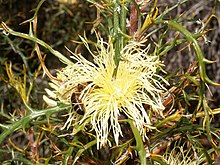Banksia comosa
Banksia comosa, commonly known as Wongan dryandra,[2] is a species of shrub that is endemic to Western Australia. It has linear leaves with widely spaced, sharply pointed serrations, heads of yellow flowers and glabrous fruit.
| Wongan dryandra | |
|---|---|
 | |
| Scientific classification | |
| Kingdom: | Plantae |
| Clade: | Tracheophytes |
| Clade: | Angiosperms |
| Clade: | Eudicots |
| Order: | Proteales |
| Family: | Proteaceae |
| Genus: | Banksia |
| Subgenus: | Banksia subg. Banksia |
| Series: | Banksia ser. Dryandra |
| Species: | B. comosa |
| Binomial name | |
| Banksia comosa | |
| Synonyms[1] | |
| |
Description
Banksia comosa is a dense, bushy shrub that typically grows to a height of 3 m (9.8 ft) but does not form a lignotuber. It has linear, often bent leaves that are 10–35 mm (0.39–1.38 in) long and 4–8 mm (0.16–0.31 in) wide on a petiole up to 20 mm (0.79 in) long. Each side of the leaf has between eight and fifteen well-shaped, sharply pointed, narrow triangular teeth. The flowers are borne in heads of 110 to 150, the heads surrounded by dark reddish brown involucral bracts that are up to 35 mm (1.4 in) long. The flowers have a yellow perianth 25–27 mm (0.98–1.06 in) long and a pistil 27–29 mm (1.1–1.1 in) long. Flowering occurs from August to October and the fruit is a broadly egg-shaped, more or less glabrous follicle 11–15 mm (0.43–0.59 in) long.[2][3]
Taxonomy and naming
This species was first formally described in 1848 by Carl Meissner who gave it the name Dryandra carlinoides and published the description in de Candolle's Prodromus Systematis Naturalis Regni Vegetabilis from specimens collected by James Drummond.[4][5] The specific epithet (comosa) is a Latin word meaning "having tufts of hairs or of leaves".[6] In 2007 Austin Mast and Kevin Thiele transferred all dryandras to the genus Banksia and renamed this species Banksia comosa.[7][8]
Distribution and habitat
Wongan dryandra grows in kwongan and is only known from Wongan Hills.[3]
Conservation status
This banksia is classified as "Priority Four" by the Government of Western Australia Department of Parks and Wildlife,[2] meaning that is rare or near threatened.[9]
References
- "Banksia comosa". Australian Plant Census. Retrieved 15 April 2020.
- "Banksia comosa". FloraBase. Western Australian Government Department of Parks and Wildlife.
- George, Alex S. (1999). Flora of Australia (PDF). 17B. Canberra: Australian Biological Resources Study, Canberra. p. 300. Retrieved 11 April 2020.
- "Dryandra comosa". APNI. Retrieved 15 April 2020.
- Meissner, Carl; de Candolle, Augustin P. (ed.) (1856). Prodromus Systematis Naturalis Vegetabilis. Paris: Sumptibus Victoris Masson. p. 478. Retrieved 15 April 2020.CS1 maint: extra text: authors list (link)
- Francis Aubie Sharr (2019). Western Australian Plant Names and their Meanings. Kardinya, Western Australia: Four Gables Press. p. 167. ISBN 9780958034180.
- Mast, Austin R.; Thiele, Kevin (2007). "The transfer of Dryandra R.Br. to Banksia L.f. (Proteaceae)". Australian Systematic Botany. 20 (1): 63–71. doi:10.1071/SB06016.
- "Banksia comosa". APNI. Retrieved 15 April 2020.
- "Conservation codes for Western Australian Flora and Fauna" (PDF). Government of Western Australia Department of Parks and Wildlife. Retrieved 15 April 2020.
- Cavanagh, Tony; Pieroni, Margaret (2006). The Dryandras. Melbourne: Australian Plants Society (SGAP Victoria); Perth: Wildflower Society of Western Australia. ISBN 1-876473-54-1.
| Wikisource has original text related to this article: |
Taxon identifiers | |
|---|---|
| Banksia comosa | |
| Dryandra comosa | |
